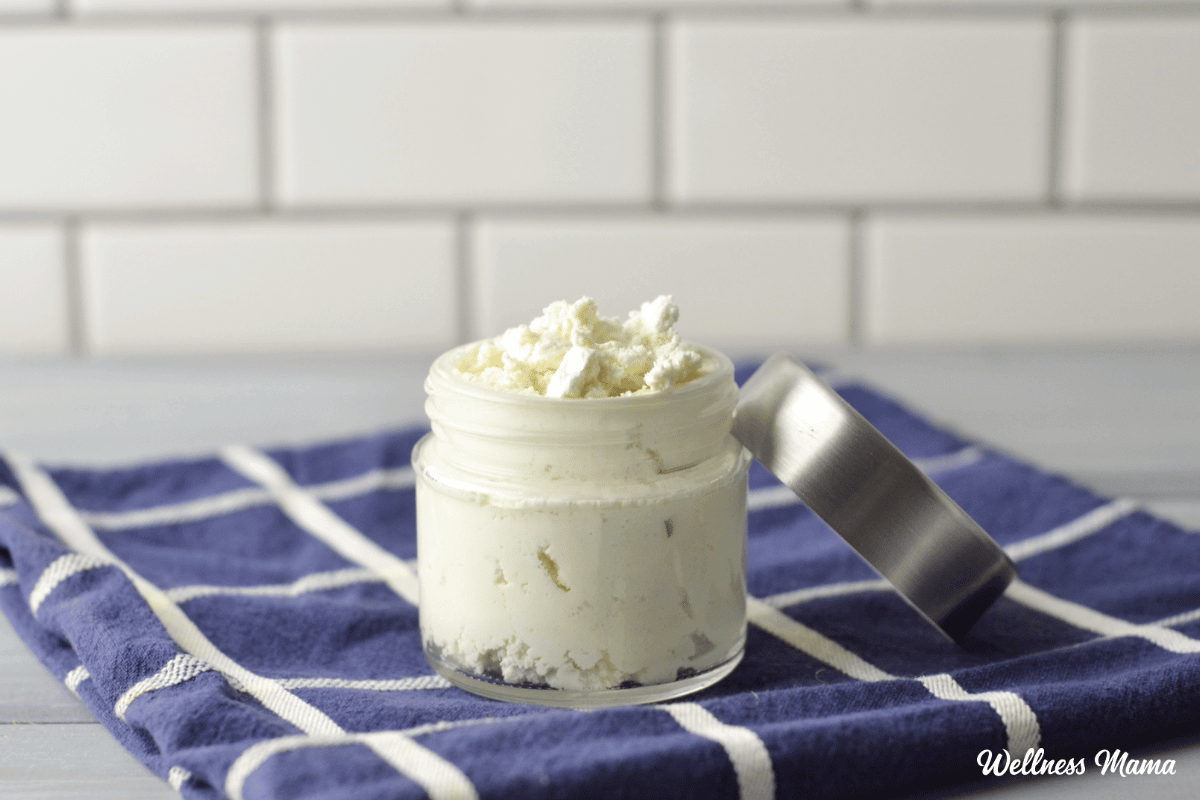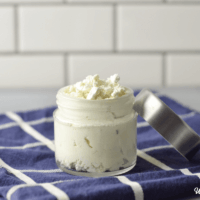Years ago I discovered the skin health benefits of tallow. While these DIY tallow lotion bars were a favorite at our house, I wanted something with a softer consistency. The result is this nourishing whipped tallow balm, perfect for even sensitive skin.
I love how it makes my skin feel so silky and soft. Plus it has natural ingredients I feel good about using with my kids too. I really saw a big difference in my son’s eczema scars after using tallow. Here’s why tallow balm is so great, how to use it, and how to make your own!
The Benefits of Tallow Balm
Unlike other moisturizers and lotions with plant oils, tallow balm is a unique creature. It all starts with animal fat (usually beef fat, but mutton works nicely too) that’s then rendered and purified. It’s similar to lard, which comes from pigs. The best fat to use for beef tallow comes from grass-fed suet or leaf fat. This leaf fat is what’s found around the kidneys.
Since tallow comes from an animal source it nourishes and soaks into our skin beautifully. It’s great for all sorts of skincare uses, from soap to lip balm, to salves. As a balm, it helps with dry skin, eczema, and anti-aging. It’s perfect for every age from babies (to help with eczema and diaper rash) on up. You can read more about the skin benefits and how to use tallow here.
Tallow Balm Ingredients
You could use just plain tallow on your skin, but it’s very firm and hard to spread. An easier way is to make tallow balm made with a mix of tallow and liquid oils. This makes it much easier to apply and you get the best of both worlds.
Some people add ingredients like shea butter, coconut oil, or jojoba oil. I like to keep things simple and mainly use extra virgin olive oil here. I’ve also added a little bit of rosehip seed oil. Since rosehip is astringent it helps the tallow soak in a little better, plus it has amazing skin healing properties. This anti-aging rosehip facial moisturizer is a reader favorite!
Many times with balms and salves I’ll add beeswax to help thicken, but you don’t need any with the tallow. You can also add some of your favorite essential oils, though it’s totally optional. Frankincense, chamomile, and lavender essential oils are some good ones to consider.
This recipe feels like a whipped body butter, or you can skip the whipping step and it feels more like a salve. Either way works, but I prefer the feel of the whipped version.
Where to Get Tallow
Ok, so maybe I’ve sold you on how awesome tallow is for skin… but where do you get it? You may be able to find high-quality grass-fed beef tallow from a local farmer in your area. If not, I also like to get my tallow online here.
Rendered tallow has an off-white color and may or may not have a beefy smell. Further purifying it helps to get rid of the tallow smell and yields a snow-white color.
How to Purify Tallow
If you’re using tallow for cooking (or even soap making) the smell isn’t strong enough to make a difference. For skincare products though you’ll want purified tallow. You can find a tutorial for how to render your own tallow here, but here’s how to purify it further.
- Add rendered tallow, 4-8 cups of water, and 3 Tablespoons of salt to a crockpot. How much water you use depends on how much tallow you have.
- Set it to low and let it simmer for about an hour.
- Strain the hot liquid into a large bowl through a fine mesh sieve lined with paper towels or a very clean tea towel or t-shirt fabric.
- Let the bowl cool in the fridge until firm.
- Remove the block of hardened tallow from the top of the salt water and flip it over. On the underside, you may see some brown bits, scrape all of these off.
- You can repeat this process once more if desired.
- Allow the tallow to air dry at room temp so all of the water evaporates (otherwise it can mold).
Once your tallow is purified, you’re ready to make your own tallow balm!
Whipped Tallow Balm Recipe
Equipment
- Stand mixer (or hand mixer)
Materials
- ½ cup tallow (purified)
- 2 TBSP olive oil (or avocado, sweet almond, etc.)
- 1 tsp rosehip seed oil (optional)
- 25 drops essential oil of choice (optional)
Instructions
- Add tallow to the top of a double boiler and melt tallow over low heat.
- Once it’s completely liquid add the olive oil and stir.
- Remove from the heat and add essential oils and rosehip seed oil if using.
- Pour the tallow balm into a glass jar and put it in the refrigerator to harden.
Whipped Tallow Balm
- For a whipped tallow balm version, pour the balm into a mixing bowl instead before putting it in the fridge. You want it to solidify to the point it’s firm, but not really hard.
- Whip the tallow balm with the whisk attachment on a stand mixer or a hand mixer. If it’s too hard to whip, then let it set at room temperature just until soft enough to whip.
- Transfer to a glass jar for storage.
Notes
- Shelf Life and Storage: Store your tallow balm at room temperature away from direct light and heat. It should last for several months if stored properly.
- This recipe uses a 1% essential oil dilution ratio. If using for children ages 6 months to 3 years old, then reduce the essential oils down to 7 drops total (.25%) or omit.
Don’t feel like making it? Toups & Co Organics makes some great tallow balms my family loves.
Have you ever used tallow on your skin before? What’s your favorite way to use it? Leave a comment and let us know!



Leave a Reply